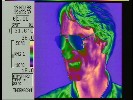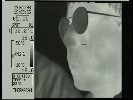

Below are examples of what may be the ultimate night viewer, a thermal infrared camera that works in the mid-IR range of 3.4-5 microns. It uses a 256x256 cooled platinum silicide focal-plane array. This was a demo of a Inframetrics ThermaCAM SC1000 that a salesman showed at our company. I recorded from its S-Video out to my DV Video Walkman during the demo, and transferred a few stills (L: myself, R: a co-worker) from that DV tape to flash card with the TRV900, to upload to my web page. These aren't intended to show the S-Video capture quality, and they certainly aren't flattering portraits, but I thought they were interesting as pictures.
This happened to be taken in normal indoor light but the image looks the same in absolute darkness- you're seeing heat radiation from the skin. This camera can see differences of 0.1 deg C and you can find some regions of greater blood flow from the heat signature. You can have a thermal imager of your very own for about $50,000. Volume discounts are available, if you want to buy several.